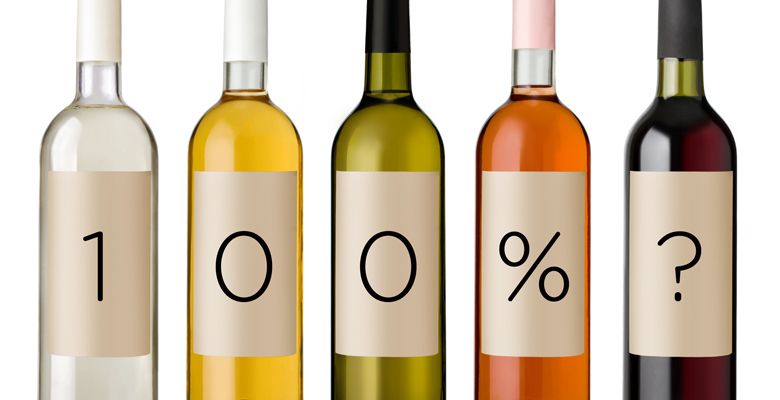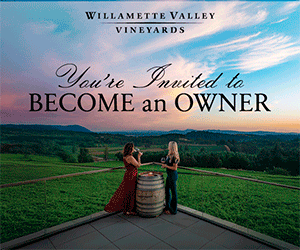Two Sides to Every Label
Willamette Valley Wineries Association initiatives spark conversation
Does it matter if a bottle of Willamette Valley Pinot Noir is produced entirely from Pinot Noir grapes or grapes grown in the Willamette Valley? Oregon has strict rules regarding wines labeled with an AVA (American Vinicultural Area), a specific grape-growing region like the Willamette Valley. If an AVA is listed on a wine label, the wine must contain no less than 95% of grapes from that area, and if it states a single grape variety, such as Pinot Noir, it must be made from at least 90% of that variety. Now, wineries in the Willamette Valley have proposed legislation to increase both standards to 100% by the year 2030.
But, does everyone in the industry agree with the proposed law? Not exactly. As with every story, there are two sides. Below, you will find opposing points of view, one from David Adelsheim, founder of Adelsheim Vineyard in the northern Willamette Valley, and the other from Michael Moore, owner of Quail Run Vineyards in Southern Oregon. OWP has invited both to explain their passionate stances.
David Adelsheim
There are few things in life as inspiring as working together to create something of value. This is how the Willamette Valley wine industry originated and why it has come so far, so fast. In just over 50 years, we’ve created a worldwide reputation for consistent, glorious wines made from Pinot Noir.
Looking back over those years from today’s vantage, we can see that much of that time was needed just to learn our craft. We needed to learn about clones, rootstocks, soils, elevations and so much more in the vineyard. That was matched in the winery by learning about tools, fermentation management, coopers and preparing our wines for bottling. We held endless discussions about such points and tasted each other’s wines, year in and year out. And we shamelessly stole the best vineyard and winery techniques from each other so that by about the year 2000, almost every winery in the Willamette Valley was creating incredible wines in almost every vintage. And the world noticed.
But what’s been our story since then? Mostly we read about new wineries starting, old wineries being sold, the inappropriate use of AVA names, and that we continue to make consistent, glorious wines every vintage. But there has been no new initiative that would mark our stepping into an even greater future.
In essence, we need to rekindle the idealism on which our industry was founded. And that is why the Willamette Valley Wineries Association has proposed legislation that will sustain the legacy of our wines by ensuring their authenticity. Authentic wine labeling is required to attract the next-generation wine consumers and to ensure that new entrants do not compromise quality in the pursuit of quantity. Our goal is nothing less than guaranteeing that what is on our wine label is what is in the bottle.
These legislative concepts did not sprout out of thin air. They are the result of two years of lengthy and heartfelt conversations among Willamette Valley winegrowers. We’ve had debates, town hall meetings, e-mail surveys and negotiating sessions to pound out the proposed legislation. In the end, more than 80% of the wineries in the Willamette Valley came to support these initiatives.
But, obviously, the Willamette Valley is not Oregon’s only winegrowing region. So we have traveled to the Columbia Gorge, and the Rogue and Umpqua valleys multiple times. We’ve had conversations with our industry cohorts in the Walla Walla Valley and Snake River as well. The reactions have been mixed. Some winemakers support the concepts. Some wanted the option to enhance the standards for their AVA as well. So we reconfigured the bills to have statewide application, allowing other AVAs to opt in as it may make sense to them.
There are those in the Oregon wine industry, who believe stricter wine content standards are unnecessary. Some vineyard owners fear economic harm. Some winemakers desire more flexible blending standards; some want certain grape varieties to be exempt and others want all varieties included. We have listened patiently to their concerns and have made significant changes to the early versions of the bills to mitigate many of the concerns they expressed. But regrettably, some opposition remains. Additional opportunities for establishing common ground will be available in the implementation of these statutes.
In the end, we could not compromise the authenticity promised by the legislative initiative. We need to reinvigorate our legacy by reinforcing quality. Enhanced wine labeling and content standards will help ensure Oregon wines are held in the highest esteem in the world.
Additional information about these bills is available at: willamettewines.com/conjunctive-and-varietal-labeling.
Michael Moore
Quail Run Vineyards is located in the Rogue Valley, but 36 of the 40 winemakers I work with are in the Willamette AVA, where the majority of big reds I sell are used in varietal wines. Through many years of collaboration, I’ve learned how Sam Tannahill wants his grapes just slightly dimpled for his Francis-Tannahill Syrah. I know the flavor profile Joe Ibrahim is after with his Griffin Creek wines and how to rein in the methoxypyrazines in Leah Jorgenson’s LJC Cabernet Franc. It’s these close collaborations that define our wine industry and that make being a grower so tremendously gratifying.
I also grow grapes used as blenders in Willamette AVA Pinot, but none of the winemakers I grow these grapes for wishes to be named. Their decision to remain anonymous is, perhaps, what troubles me most about the proposed legislation. They use blenders judiciously, as allowed by current rules, because they believe it makes a better wine. It’s part of their creative toolkit, part of what they view as the art of winemaking. Yet they fear being ostracized or judged.
I have deep respect for this latter group of winemakers and trust they know what they’re doing. Banning them from blending according to their own winemaking preferences seems like an extreme measure. Indeed, it’s a judgement call I believe is best left to the consumer. If blending makes inferior wine, it won’t sell, simple as that. But to date, I have never heard of a consumer, critic, distributor or sommelier complain about our current blending rules. To the contrary, Oregon’s phenomenal reputation for world-class Pinot has been achieved under these rules.
So, when you’re the envy of the industry, why change the rules?
The fact is, Oregon already has the most restrictive blending laws in the nation. That one group of winemakers should now try to impose even stricter rules on all other winemakers seems draconian, especially when you consider that just two out of over 1,400 AVAs in the U.S., France, Italy and Spain currently require what SB 830A proposes.
To be clear, current rules allow any Willamette winemaker to use 100% AVA and 100% varietal grapes in their wine, and to advertise this on their label and in their promotional materials. What current rules don’t allow is for them to force their neighbor do the same.
It’s implied in these bills that the addition of 5% of Southern Oregon fruit will noticeably diminish the quality of Willamette wines. I’d challenge anyone to try a blending experiment to see if this is true.
What is true, however, is that these bills are creating a rift between North and South that hasn’t existed before. And for those who have planted vineyards in response to Willamette’s demand for blenders — I’m one of them — the threat to our businesses is real and deeply troubling.
Proponents of SB 830A now argue that new rules are needed to preserve a “sense of place.” But their original justification, and what I believe still motivates SB 830A, is the realization that Willamette’s 3,000-square-mile AVA is ripe for exploitation. Their fear is that out-of-state, corporate wineries will destroy Oregon’s hard-won reputation by producing low-quality, over-cropped Willamette AVA wines and doctoring them up with blenders.
I understand these fears. I’ve met the new players. They dwarf our largest producers. And they smell opportunity. Some, no doubt, will integrate well and contribute to our industry. Others will come simply to exploit our reputation and high bottle price. This is the threat Oregon’s wine industry must address, and soon. But it’s not a threat we can — or should — legislate our way out of, nor is it one that can be solved by dictating winemaking styles or undermining the extraordinary spirit of solidarity that is the hallmark of our wine industry.











